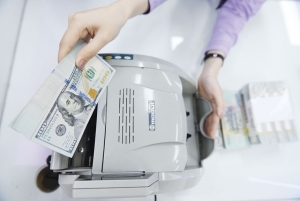Pressure on exchange rate takes on new look
 |
| The interest rate difference between VND and USD is expected to shrink further this year, Le Toan |
According to economist Le Xuan Nghia, one of the biggest risks to the Vietnamese economy is that lending rates remain high despite the State Bank of Vietnam’s (SBV) recent efforts to reduce operating interest rates. “The real interest rate is still at 10 per cent, which is too high, but this is because the operator is still worried about exchange rate fluctuations,” said Dr. Nghia.
According to a senior leader at BIDV, the increasing pressure on the exchange rate earlier in the month mainly stemmed from the increase in the US/China exchange rate in the international market of about 5 per cent to 7.25 within 2 months. At the same time, the demand for foreign currency to hedge risks increased in the context of very low swap transaction costs.
“In addition, the market sentiment was also affected to a certain extent when the USD/VND exchange rate on the free market also increased strongly during this period. However, the increase in the exchange rate quickly cooled down after that when the domestic foreign currency supply-demand balance tended to be more abundant,” the BIDV leader said.
According to data from the General Statistics Office, the trade balance in July reached a surplus of $2.15 billion - the highest level in recent years, reinforcing the surplus trend since the beginning of the year to a record $15.23 billion. Moreover, foreign direct investment disbursement also tended to recover strongly, hitting $1.72 billion, the largest rise since the beginning of the year.
However, exchange rate pressure increased not only in July but also in early August. The interbank USD/VND traded at 23,761 on August 3, an increase of nearly 0.8 per cent compared to the end of June. Since the beginning of 2023, the interbank exchange rate has increased by about 0.5 per cent while the market rate has increased by 1 per cent.
“Hoarding and speculating in foreign currencies is no longer popular, when people have partly learned lessons after the fluctuations of the exchange rate last year,” added the BIDV leader. “The market’s confidence has been further strengthened with regulators’ proactive and flexible management measures to stabilise the value of the VND.”
According to Dinh Quang Hinh, head of Macro and Market Strategy at VNDirect, there are factors that can put pressure on the VND exchange rate in the second half of 2023. Specifically, the interest rate difference between VND and USD will continue to shrink as the Fed’s operating interest rate may remain at the peak until the end of 2023 to curb inflation, while the SBV is oriented to continue lowering interest rates to support growth. At the same time, domestic inflation may increase from the end of the third quarter of 2023.
“However, the VND exchange rate will still be supported by a high trade surplus and stable overseas funding and remittances. In addition, the agreements to sell shares to foreign investors expected to be implemented in the second half of 2023 will increase the supply of foreign currency, and Vietnam is a country that currently maintains high real interest rates,” said Hinh.
According to economist Nghia, the domestic foreign currency supply-demand balance has been a big fulcrum for the exchange rate in the past period, and August’s movements may not be an exception. History shows that August is the peak period of trade surplus, with a trade balance surplus forecasted to reach about $2.5-3 billion this year when exports improve as Samsung launched a new product line.
“In addition, it is expected that VPBank’s capital sale to foreign partners will also be implemented soon in the near future to improve the foreign currency supply in the market, estimated at $1.3-1.5 billion if successful,” Nghia said.
He mentioned three factors that make it difficult for the SBV to have more room to reduce operating interest rates. “Firstly, the USD Index may drop further to the threshold of 100 points. It is unlikely to rise again in the context of the current multipolar world, using many currencies. Secondly, the price of imported raw materials may increase, especially fuel prices, but the Ministry of Finance still has room to intervene, such as reducing taxes and petrol fees. Thirdly, Vietnam’s balance of payments is still positive.”
 | Softer exchange rate loom in H2 The USD/VND exchange rate is forecast to abate in the months to come, leveraging diverse supportive factors in both domestic and international markets, as well as central bank movement. |
What the stars mean:
★ Poor ★ ★ Promising ★★★ Good ★★★★ Very good ★★★★★ Exceptional
Related Contents
Latest News
More News
- Tax sector wraps up 2025 and sets priorities for next year (December 25, 2025 | 14:00)
- A tipping point for digital and hybrid wealth management in Vietnam (December 23, 2025 | 13:33)
- $250 million deal targets women-owned SMEs, sustainable agriculture (December 22, 2025 | 17:40)
- Stock market posts resilient 2025 performance (December 19, 2025 | 18:17)
- Citi Vietnam receives 2025 AmCham CSR recognition (December 19, 2025 | 16:35)
- As global green supply chain reshapes, will Vietnam be left behind? (December 19, 2025 | 08:00)
- Banks gear up for massive capital increases (December 18, 2025 | 17:04)
- Securing capital and efficiency for Vietnam’s 2026-2030 growth ambitions (December 17, 2025 | 10:00)
- Energy sector in need of blended finance mechanisms (December 17, 2025 | 09:00)
- Vietnam still has room to mobilise capital for sustainable growth (December 17, 2025 | 08:57)

 Tag:
Tag:





















 Mobile Version
Mobile Version